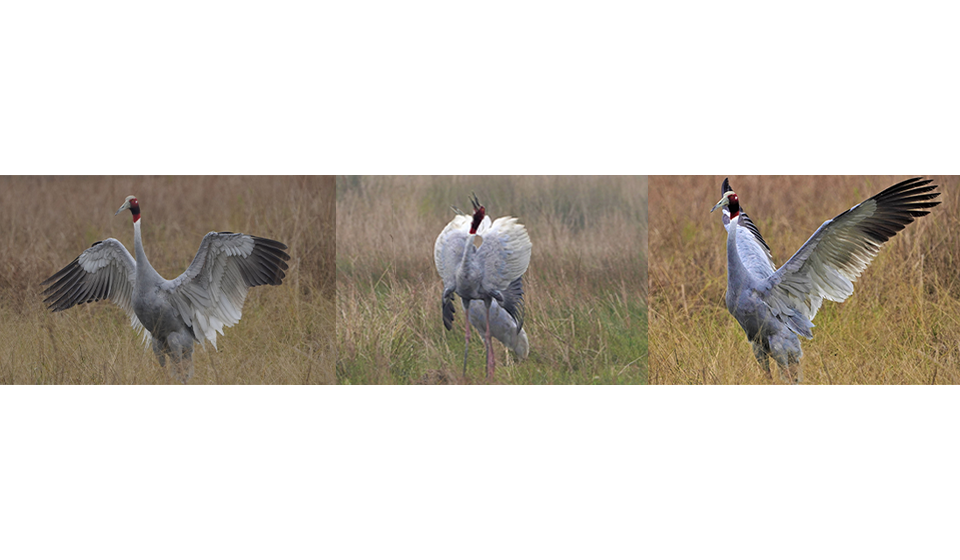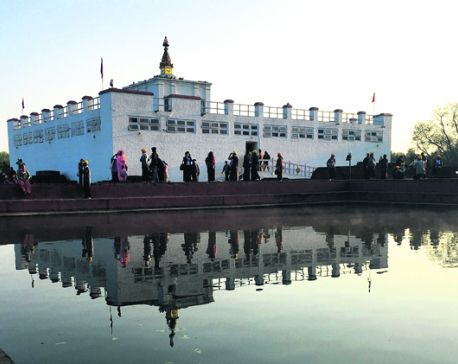
OR
Opinion
Protecting the wetlands and Sarus Cranes of Lumbini
Published On: February 1, 2022 06:30 AM NPT By: Rajendra Suwal

More from Author
Akin to so many bird species that dwell in the farmlands of Lumbini, Sarus Cranes also rely on the surrounding wetlands and farmlands for survival. Unfortunately, their survival remains at stake owing to food scarcity resulting from loss of wetlands, increasing pollution and hazardous linear infrastructures.
Lumbini forest is an ancient forest with a riveting history. It is known to have served as a recreation estate to the Shakya dynasty of Kapilvastu and Koliya dynasty of Devadaha. The forest, also declared as Abhaya Ban (armistice forest), is the place where Prince Siddhartha was born. It is believed that the newborn prince instantly walked seven steps on a lotus that bloomed over the Pushkarni pond signifying the arrival of the enlightened one.
Besides being a World Heritage site and rich in history, Lumbini is also home to diverse bird species including Sarus Cranes, the tallest flying bird in the world, and some spectacular wildlife such as the Blue Bull antelope, spotted deer, wild boar, and jackals. Legend has it that Lord Buddha treated a Sarus crane injured by his cousin Devdutta in Lumbini. Ever since, Sarus Crane has been closely associated with Lord Buddha and Lumbini and revered by the community. Akin to so many bird species that dwell in the farmlands of Lumbini, Sarus Cranes also rely on the surrounding wetlands and farmlands for survival. Unfortunately, their survival remains at stake owing to food scarcity resulting from loss of wetlands, increasing pollution and hazardous linear infrastructures.
Other anthropogenic causes that account for their dwindling number include casualties from collision with power cables, falling prey to predators such as jackals and stray dogs and killing for consumption purposes. Following the eradication of Malaria in the 1960s, the forest in the lowlands of Nepal including Lumbini were stripped off its tree covers - the pristine forest, grassland and wetlands were converted into agricultural fields. The absence of forest covers that traps monsoon rain led to decrease in groundwater recharge capacity.
Prolonged dry period and diminishing wetlands compelled the birds to fly away in search of a better and more suitable place. Over the years, the problem was compounded by unplanned urbanization, construction of linear infrastructure such as regional airports, four lane highways, extension of power cables, growing numbers of tourism infrastructure, higher chemical inputs in farms, and industrial effluents polluting air, rivers, and wetlands.
Considering the dire situation, the International Crane Foundation and WWF Nepal in partnership with Lumbini Development Trust initiated wetland restoration and Sarus Crane conservation program aimed at rewilding Lumbini in 1988. Efforts were put in place to ensure active management of wetland, including water impoundments for waders, waterfowl conservation and sound conservation education awareness program. WWF Nepal in partnership with Lumbini Development Trust also initiated the Green Lumbini campaign with the objective of providing climate resilient habitat through rainwater harvesting in Lumbini Crane Sanctuary. Rainwater harvesting helps enhance wetland habitat for endangered wildlife, enhances ground water recharge and prevents flash flood.
Similarly, 10 wetlands were enhanced through construction of dykes with an area of 20 ha, and a capacity to store nearly 100 million liters of monsoon precipitation. Plantation of wild rice and Kalanamak native rice was also supported to provide forage and refuge for Sarus Cranes. Beyond this, over hundred Brown-roofed turtles, a rare Elongated Tortoise and fishes were translocated from the drying pond of Sacred Garden to the wetland of Lumbini Crane Sanctuary, resulting in a vibrant avifauna of over 200 species in and around the farmlands of Lumbini. Communities, youth and eco clubs of Lumbini were mobilized to conserve their neighboring wetlands and promote tree and Kala Namak rice plantation. The local farmers of Lumbini have played a significant role as custodians of wildlife and bird species found in this area specially Sarus Cranes and the collective efforts of the communities, development partners and all stakeholders have paid off.
Hundreds of Sarus Cranes now flutter in the farmlands and wetlands of Greater Lumbini Area and further west. Lumbini Crane Sanctuary and surrounding farmlands has also been declared as Important Bird and Biodiversity Area (IBA) by Birdlife International, indicating the success of our efforts. At present, Lumbini Crane Sanctuary serves as an important habitat for resident and migratory birds.
The emergence of a vast array of birds and wildlife including Sarus Crane along with the return of rich biodiversity, is an encouraging indicator of healthy wetland, essential for their survival. Lumbini Crane Sanctuary has emerged as a model for effective wetland management and Sarus Crane conservation - a success that complements the theme for World Wetlands Day 2022 “Wetlands Action for People and Nature”. However, there is a need to further capacitate government and development partners to promote green linear infrastructure and organic farming to protect the wetlands and sustain conservation efforts. This calls for exchange and learning of best practices, formulation of favorable policies for land zonation by demarcating and safeguarding wetlands and rivers.
You May Like This

Pashupatinath temple, Lumbini included in World Book of Records
KATHMANDU, Nov 12: World Book of Records, London, has listed Nepal's Pashupatinath Temple and Lumbini, the birthplace of Lord Gautam... Read More...

Thai Princess Sirindhorn arrives Lumbini
BUTWAL, Oct 20: The visiting Thai Princess Maha Chakri Sirindhron arrived Lumbini in Rupandehi district today to mark cultural and... Read More...

Sankata, Lumbini fix semifinal meeting
KATHMANDU, June 23:CMG Club Sankata and Jagadamba Lumbini Football Club fixed the semifinal meeting winning their respective quarterfinal matches on... Read More...




Just In
- KMC to organize a month-long skill fair from May 1
- Birgunj Metropolis collects over Rs 360 million in revenue
- NEPSE plunges below 2,000 points after one and a half months; daily turnover declines to Rs 2.10 billion
- AI Index Report-2024: AI still behind humans on complex tasks like competition-level mathematics
- Daiji-Jogbudha road construction at snail’s pace
- Govt fails to adopt podway technology despite its potential in Nepal
- Jhulaghat border crossing in Baitadi to remain closed from this evening
- Universities will be free from partisan interests: Education Minister
















Leave A Comment